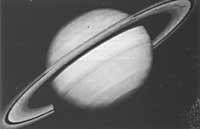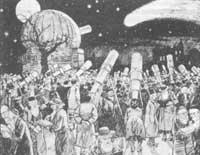Astronomical phenomena and ephemeris
1990/03/01 Arregi Bengoa, Jesus Iturria: Elhuyar aldizkaria
In the last three issues, leaving the issues related to the Solar System, we have moved a bit away from the SN 1987-A supernova. This issue aimed to return to the surroundings of the Solar System to communicate the first results of the information sent by Voyager 2 in August on Neptune and its satellites. However, we will leave this batch of articles for later, in order to respond to some requests in this and the following number.
On the one hand, we begin in this issue and from now on we will give a space to the most important astronomical phenomena and ephemeris of this month. We call phenomenon, of course, special situations that can present us the stars in the mass. Ephemeris are usually called data and coordinates to be able to locate stars or study phenomena, such as the position of the Sun, indicating to which constellation will move, the phases of the Moon and other ephemeris, the conditions of observation of the planets, etc.

We must keep in mind that when using the data there are always hours in universal time (UT, universal time). Therefore, to get the official time you have to add one hour in autumn and winter, and two in spring (this year from March 25) and summer.
Thus, throughout the month of April the most significant phenomena and some observations that can help us look at the kneading will occur:
SUN
He joined the Constellation of Taurus on April 20, 8 and 26 (UT). Therefore, this constellation of day would be seen in the back of the Sun if its light darkened, for example if there were a total eclipse of the Sun. Although we are not going to mention hereafter, we must know that all the Constellations have a displaced place compared to the place they had at the time when they were called about 2000 years ago. That is, the point that represents the beginning of spring, by effect of the precession of the equinoxes, is not at the beginning of the Constellation of Aries, as it was then and still is said by custom. In fact, the point is in Pisces, so when we say that you are going to enter Taurus we must know that you are going to enter Aries.
LUNA
The Crescent Moon is April 2; day 10, 3 and 18 minutes (UT); day 18 and 25 April. The Moon will be in the perigee on the same day as it is a new moon, although the two phenomena occur at different times. From the Apogee passes to 12.
PLANETS
As
for the planets, we will only mention those that can be seen at a glance. As for these, April is not a bad month, because we can see them all.
- MERCURY will
be present in the best visibility conditions during the first half of the month. It is seen at dusk, up to an hour or an hour and a half after sunset. It must be taken into account, however, that Mercury is invisible due to its low height in the sky (the main axis of its orbit is small and therefore moves little away from the Sun), which is seen along with the last lights of the day. Reaches its maximum elongation East, 20th, on April 13. Stop on April 23. - The maximum
elongation of VENUS West (46), which will reach 30 March, can be seen throughout the month of April. It appears in the morning until the day opens. - MARTITZ
leaves shortly before Venus on the Southeast horizon and can be distinguished by its reddish color. - JUPITER We can
see it as soon as it darkens, but we will see it every day below. Therefore, each time it is hidden before other planets appear. - SATURN
We will also see it in the morning, but well before Martitz and Venus. It will look brighter than Martitz and the orientation of its rings is very suitable for observation with a small telescope.
In April the Moon will not hide luminous stars.
As for shooting stars, we must mention the Lirids. They are seen from the boundary of the Constellations of Hercules and Lyra. The maximum intensity will be reached on April 22, with 20 meteors per hour. They will be seen from midnight, 20 to 23. They are high speed.
Making known the observations made on this occasion, we will try to summarize in a table the following information for the following numbers.
The second topic to mention refers to the position of the planets and their way of knowing. One of the first problems that the fan wants to solve is the location of the planets, or more specifically, knowing where the telescope should lead to see the planet. In addition to the annotations that we will issue monthly, in the next issue, each one will give us “discoverers” to calculate the positions with enough precision. Next we will see in the planiscope the stars that we must use as a reference to find the planet.

Gai honi buruzko eduki gehiago
Elhuyarrek garatutako teknologia




